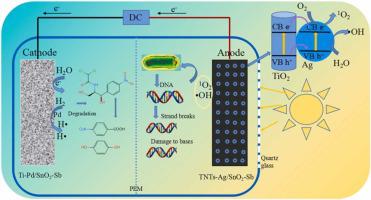Journal of Hazardous Materials ( IF 12.2 ) Pub Date : 2021-10-20 , DOI: 10.1016/j.jhazmat.2021.127553 Huan He 1 , Tianguo Zhao 1 , Qicheng Ma 1 , Xiaoxia Yang 1 , Qingsong Yue 1 , Bin Huang 2 , Xuejun Pan 2

|
Antibiotics, antibiotic resistant bacteria (ARB) and antibiotic resistance genes (ARGs) are ubiquitous in the reclaimed water, posing a potential threat to human and ecological health. Nowadays, the reuse technology of reclaimed water has been widely concerned, but the removal of antibiotics, ARB and ARGs in reclaimed water has not been sufficiently studied. This study used TiO2 nanotube arrays (TNTs) decorated with Ag/SnO2-Sb nanoparticles (TNTs-Ag/SnO2-Sb) as the anode and Ti-Pd/SnO2-Sb as the cathode to construct an efficient photoelectrocatalytic (PEC) system. In this system, 99.9% of ARB was inactivated in 20 min, meanwhile, ARGs was removed within 30 min, and antibiotics were almost completely degraded within 1 h. Furthermore, the effects of system parameters on the removals of antibiotics, ARB and ARGs were also studied. The redox performance of the system was verified by adding persulfate. Escherichia coli, as a representative microorganism in aquatic environments, was used to evaluate the ecotoxicity of PEC treated chloramphenicol (CAP) solution. The ecotoxicity of CAP solution was significantly reduced after being treated by PEC. In addition, transformation intermediates of CAP were identified using liquid chromatography-tandems mass spectrometry (LC-MS/MS) and the possible degradation pathways were proposed. This study could provide a potential alternative method for controlling antibiotic resistance and protecting the quality of reclaimed water.
中文翻译:

光电催化耦合系统协同去除水生环境中的抗生素和耐药菌
再生水中普遍存在抗生素、抗生素耐药菌(ARB)和抗生素耐药基因(ARGs),对人类和生态健康构成潜在威胁。目前,中水回用技术受到广泛关注,但对中水中抗生素、ARB和ARGs的去除研究还不够。本研究使用装饰有 Ag/SnO2-Sb 纳米粒子 (TNTs-Ag/SnO2-Sb) 的 TiO2 纳米管阵列 (TNTs) 作为阳极, Ti-Pd/SnO2-Sb 作为阴极来构建高效的光电催化 (PEC) 系统。在该系统中,99.9%的ARB在20分钟内被灭活,同时ARGs在30分钟内被去除,抗生素在1小时内几乎完全降解。此外,还研究了系统参数对抗生素、ARB 和 ARGs 去除的影响。通过添加过硫酸盐验证了体系的氧化还原性能。大肠杆菌作为水生环境中的代表性微生物,用于评估 PEC 处理的氯霉素 (CAP) 溶液的生态毒性。CAP溶液经PEC处理后生态毒性显着降低。此外,利用液相色谱-串联质谱(LC-MS/MS)鉴定了CAP的转化中间体,并提出了可能的降解途径。这项研究可以为控制抗生素耐药性和保护再生水的质量提供一种潜在的替代方法。CAP溶液经PEC处理后生态毒性显着降低。此外,利用液相色谱-串联质谱(LC-MS/MS)鉴定了CAP的转化中间体,并提出了可能的降解途径。这项研究可以为控制抗生素耐药性和保护再生水的质量提供一种潜在的替代方法。CAP溶液经PEC处理后生态毒性显着降低。此外,利用液相色谱-串联质谱(LC-MS/MS)鉴定了CAP的转化中间体,并提出了可能的降解途径。这项研究可以为控制抗生素耐药性和保护再生水的质量提供一种潜在的替代方法。







































 京公网安备 11010802027423号
京公网安备 11010802027423号